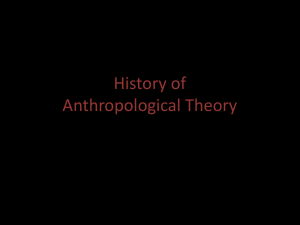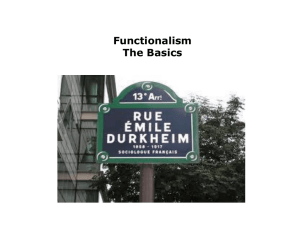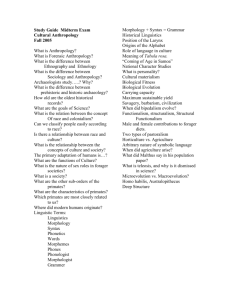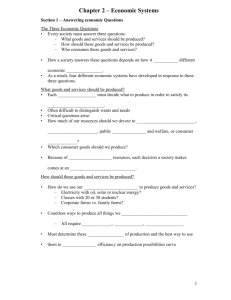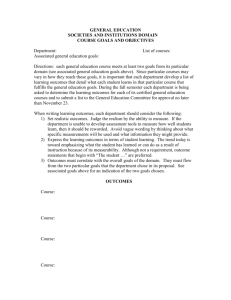Social Theories
advertisement
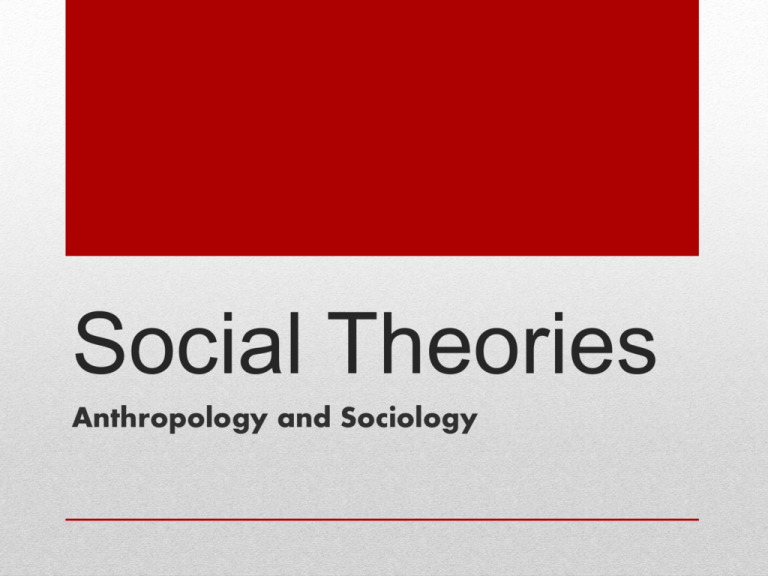
Social Theories Anthropology and Sociology Unilineal Evolution (1850s –1900s) Anthropological Theories Context for Unilineal Evolution • 19th Century: • Colonialism – economic & political domination • Transfer of wealth to Europe • Increasing Racism 3 Religion • 3 Orientations 1. Polygenists: Separate creations • Races are distinct species 2. Monogenists: One creation • Biblical interpretation • All races with ability to progress • “White Man’s Burden” 3. Degeneration: Single creation • Regression after creation 4 Polygenists Separate Creations Can’t Achieve Civilization Monogenists Capable of Advancement Degenerationists Punishment for Falling from Perfection Unilineal Evolution • Process by which new cultural forms emerge out of older ones • Each Society believed to PROGRESS through the same stages of development, from • SAVAGERY to BARBARISM to CIVILIZATION • Only Europeans had reached civilization 7 Civilization Barbarism Savagery 8 Basis for Unilineal Evolution • Application of biological evolution to culture • Interest in general laws, not history • Ranking societies on a scale of progress • Armchair anthropologists 9 Armchair Anthropologists • 19th century Evolutionists collected data from missionaries and traders • Rarely traveled to societies they were studying • Organized second hand data and applied general theory to all societies • Since Western societies had most advanced technology, they put those societies at the highest rank of civilization • 19th century Evolutionists contributed to anthropology: • By providing first systematic methods for explaining human societies • Insightful about technological aspect of societies • Logical progression from simple tools to complex technology Historical Particularism • Early 20th C. paradigm change • Professionalization of anthropology • Represents a reaction against unilineal evolution • Division between British & American anthropology • Omnibus approach 12 Assumptions of Historical Particularism • Rejects: • General laws • Rankings (on a scale) • “Progress” Franz Boas • No simple or complex societies, only different societies • Not Culture, but cultures • Culture, not race, determines behavior • Methodological rigor 13 Culture & Personality (Psychological Anthropology) Mead Benedict • 1930-50s – Students of Boas • Borrowed from psychology • Focus on the individual as the bearer of culture • Idealist approach: Interest in personality & how individuals thought, felt • Studied process of enculturation, especially child development 14 European Ethnocentrism Timeline of European Religions Diffusionism • During late 19th and early 20th centuries • Diffusionists addressed cultural differences suggesting that humans were essentially uninventive • Cultural features developed in one or several parts of the world and • Spread, through the process of diffusion, to other cultures Diffusionists • All societies change as a result of cultural borrowing • Use deductive approach: General theory of diffusion applied to explain specific cases of cultural diversity • Diffusionism overemphasized the essentially valid idea of diffusion The Silk Road • The Examples of Cultural Diffusion Functionalism • No matter how bizarre a cultural item might at first appear, it had a meaning • Performed some useful function • Well-being of individual or society • Researcher to become immersed in culture and language to identify functions Functionalism The functionalist approach is based on two fundamental principles: 1. Universal Functions • Every part of a culture has a function 2. Functional Unity • A culture is an integrated whole composed of a number of interrelated parts; • A change in one part of the culture is likely to produce change in other parts British Functionalism • Society consists of institutions (or structures, systems) that serve vital purposes for people • Functionalists not interested in evolution of societies • But relationship among different systems, or structures, and • How these structures serve society or individual Structural functionalism – A.R. Radcliffe-Brown • Focused on how societal structures function to maintain harmony in society. • Economic, social, political, and religious institutions (or systems) integrate society as a whole • Perpetuate survival of society • Anthropology should not focus on individual actions, but focus on governing structures. • Societal norms (which guide behavior) are window into those structures; • Function to reduce tension & conflict, promote stability, and thus uphold the social structure. A.R. Radcliffe-Brown • Because of emphasis on social functions rather than individual functions • Radcliffe-Brown’s theory has taken the name STRUCTURAL FUNCTIONALISM Psychological Functionalism Bronislaw Malinowski • How elements of society function to meet needs of individual • Identified three basic types of needs: • 1) Biological (food, sex); • 2) Instrumental (protection, education, social control) and • 3) Integrative (a common worldview). • People developed institutions (or patterned ways of behaving) • Examples: Religion, kinship systems • Use of magic in situations where humans have no control over circumstances weather, illness, death French Structuralism • Theoretical orientation holding that cultures are the product of unconscious processes of the human mind • Claude Levi-Strauss French Structuralism • Rather than examining attitudes, values and beliefs, • Structuralists concentrate on what happens at the unconscious level • The human mind categorizes phenomena in terms of binary oppositions. French Structuralism • Binary opposites examples: • • • • • • hot-cold male-female old-young night-day right-left us-them • These dichotomies give shape to culture. • Cultural systems are most influenced by such material things as natural resources and technology Marvin Harris Cultural Materialism Cultural Materialism • Key determinants in sociocultural evolution: • Technology Environment Energy Food Economy • Harris believes that material needs (food, technology, clothing, shelter) • Are more important than abstract (values, ideas, religion) in determining cultural behavior • Example: (Much criticism of this model.) • Aztec human sacrifice and cannibalism • To Aztecs: A religious ritual • To Harris: Protein deficiency craving for meat Insufficient protein in the Aztec environment need for protein human sacrifice & cannibalism • Structural-Functionalism • Conflict theory • Symbolic Interactionism Sociological Theories Structural–Functional Paradigm • Macro-level: Broad patterns that shape society as a whole • Society as complex system: Parts work together to promote solidarity and stability • Social structure = Relatively stable patterns of social behavior • Social function=Consequences for operation of society as a whole Structural-Functionalism • Society is like human body or other living organism • Each part of society contributes to the whole • To maintain social stability Founders of Functionalism • August Comte (1798-1857) • Herbert Spencer (1820-1903) • Émile Durkheim (1858-1917) Social-Conflict • Macro theory • Inequality generates conflict and social change • Power • Society structured to benefit a few at expense of majority • Race, sex, class, and age • Dominant group vs. minority group Founders: Social-Conflict Theory • Karl Marx • Social class inequality and social conflict • W.E.B. DuBois • Race major problem for United States in 20th c. • Harriet Martineau • Position of women and their education • Jane Addams • Hull House for immigrants Symbolic Interactionism • Micro-level • Focus on social interactions • Use symbols with shared meanings Symbolic Interactionism • Society • Shared reality that people construct as they interact • Meaning people attach to behavior • Self • Social creation of the self • Interaction Founders: Symbolic-Interactionism • Max Weber • Intersubjective understanding • George Herbert Mead • Mind, self, and society • Erving Goffman • Dramaturgical analysis

